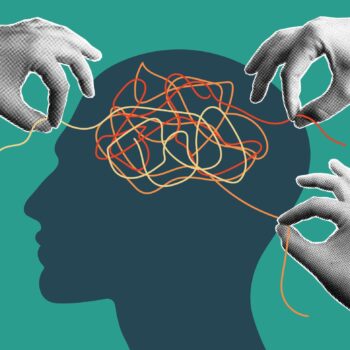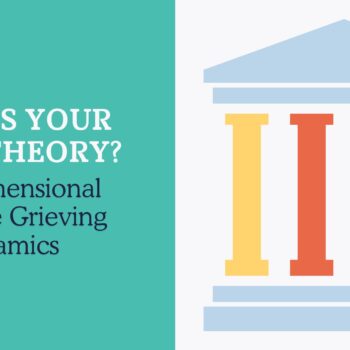Finding Glimmers in Grief
/ General : Eleanor Haley
In grief we think a lot about triggers – those cues in the world around you that leave you doubled over with a surge of grief. It could be a song on the radio, the smell of perfume, unexpectedly stumbling across something with their handwriting, seeing a family out after a graduation when this is the year they should have graduated, and on and on.
We've, of course, written about coping with grief triggers because they're such a common grief experience. However, today, we'd like to introduce a new concept that can help with grief triggers called "glimmers." Glimmers can actually be thought of as a counterpoint to triggers. They're easy to miss, but when you find them, they can be little lifeboats that keep you afloat when needed, so it's worth talking about them.
To Understand Glimmers in Grief, We Must Understand Triggers
Deb Dana, a renowned trauma therapist, has spent her career helping trauma survivors better understand their nervous systems. Any griever knows that a trigger can spring a well of tears, sending you running to hide in the nearest bathroom. But we don’t always consider what is happening at a physiological level. Triggers activate the stress response in the nervous system. Depending on the intensity of the trigger and your own unique trauma and stress response, a whole range of things can start happening in your body.
Activation of the Amygdala: This is the brain's threat detection system. When it perceives a trigger related to past trauma or grief it can signal a threat, which initiates the fight-or-flight response (there are reasons you find yourself running to your car and just wanting to be safe at home!)
Release of Stress Hormones: The amygdala activates the hypothalamus. This is the part of the brain that release stress hormones like cortisol and adrenaline, which prepare the body for a threat.
General Engagement of the Sympathetic Nervous System: In preparing our body to respond to the threat, this system:
- Increases heart rate and blood pressure
- Induces rapid breathing
- Blood vessels constrict and muscle vessels dilate
- Blood is pushed away from the digestive system
- Pupils dilate
- Increased sweating begins
The Prefrontal Cortex is Quieted: This is the part of the brain responsible for rational thinking and decision-making. We need it to think, so it isn’t ideal that a stress response can take it off-line. But the reality is the prefrontal cortex can become suppressed, leading to difficulty thinking clearly, problem-solving, and regulating emotions.
Activation of the Hippocampus: The hippocampus, a big part of the memory system, can be activated. This leads to vivid recall of grief-related memories, which of course intensifies the emotional response
Dissociation: Some individuals may experience dissociation, a disconnection from thoughts, feelings, memories, or sense of identity, as a coping mechanism for overwhelming emotional distress. If you’ve ever rushed out of somewhere in the face of a trigger, only to arrive home with no clear memory of what exactly happened between the trigger and home, you’re brain might have dissociated in an effort to protect you from the emotional pain.
Yikes, that’s a lot!
Where do Glimmers Come In?
It’s a lot to consider all that is happening in the body when we encounter grief triggers. But it can be helpful to tune into our physiology as a way of learning to soothe and calm ourselves in the face of triggers. Being able to slow your breathing, find connection to reassure yourself that you are safe (distressed, but safe), and using grounding techniques to bring yourself into the present moment are all really helpful and simple approaches. There are many resources on YouTube to help with regulating your nervous system.
In grief, there are so many big and small triggers. The world without our loved ones feels new and uncertain, a state that itself can create low-level stress. We are so deep within the despair of loss that it can feel like pain is all we notice. Our brain has a negativity bias that notices these sources of fear and distress than anything else. This is where glimmers come in.
Deb Dana introduced the idea of glimmers as the (unofficial) opposite of triggers. They’re the small moments that cue a sense of safety and calm in us when we take the time to notice them. Finding glimmers in grief can help us restore a belief that there are still moments and things in our world that are warm, safe, calm, and nurturing. Training our brains to look for these glimmers helps the nervous system shift towards a state of calm, social engagement and safety. Fostering these feelings of well-being and connecting with calm and safety can become buoys in a stormy sea.
A Glimmer Practice
The thing about triggers is that they knock us down – we struggle to avoid them even when we want to. Glimmers, on the other hand, are easy to miss. Our brain is worried about threats to our safety and well-being – that’s what it is wired to find in our environment and to commit those things to memory. Unfortunately, we have to make a conscious effort to seek and remember the things that remind us that we are safe and connected.
In her book Anchored Dana says, “Your body is built with the capacity to find glimmers. It just is . . . Setting an intention is a way to support this new practice. For example, "my intention is to notice the glimmers that are on my path today.”
Finding glimmers in grief may not come naturally, but we can create an intention to notice them. That doesn’t eliminate or counteract the triggers. But it does remind us that the world is more than just the triggers.
Tuning in to Your Nervous System
Chances are you can feel your body activate when you’ve encountered a trigger. But can you feel the moments your nervous system calms? This takes a little more practice, but you work on body attunement you’ll slowly be able to build your awareness. What helps your muscles to relax? When do you feel tension releasing? Where do you feel safe and comfortable? When you tune into these changes, your often in the presence of a glimmer. A friend with whom you feel completely at ease. A sunset and cup of tea that allows the tension to drain from your shoulders. Playing with your dog and feeling that little bump of oxytocin that helps you feel
Are Glimmers the Same as Gratitude?
We’ve talked about gratitude around here before. There’s no question that we’re often grateful for glimmers in grief. But a key distinction is that glimmers focus on a parasympathetic nervous system state associated with rest, digestion, and social engagement. Glimmers are immediate, present-moment sensory experiences that promote a sense of safety and calm.
Gratitude involves a more cognitive approach. A gratitude practice focuses on recognizing and appreciating positive aspects of life to foster a positive mindset. That can include things from the past or the present, and they aren’t necessarily things that calm our nervous systems in moment. On the other hand, we notice and connect with glimmers in the moment. Noticing how they change the feeling our bodies and brains in real time is a critical piece of glimmers.
No question these two things compliment each other, but the subtle differences are important.




